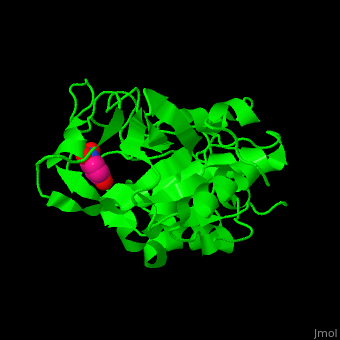Cathepsin
From Proteopedia
(Difference between revisions)
| Line 3: | Line 3: | ||
[[Cathepsin]] (CTS) is a protease which becomes activated at low pH. It is found in lysosomes. Members of the CTS group are denoted as CTSA, CTSB etc and cleave proteins at different peptide bonds. The CTSs are expressed as an inactive precursor pro-CTS (PCTS) which becomes active when a long residue prosegment is cleaved off producing the mature CTS (MCTS).<ref>PMID:15751268</ref> | [[Cathepsin]] (CTS) is a protease which becomes activated at low pH. It is found in lysosomes. Members of the CTS group are denoted as CTSA, CTSB etc and cleave proteins at different peptide bonds. The CTSs are expressed as an inactive precursor pro-CTS (PCTS) which becomes active when a long residue prosegment is cleaved off producing the mature CTS (MCTS).<ref>PMID:15751268</ref> | ||
| + | |||
| + | *CTS B is a cysteine protease.<br /> | ||
| + | *CTS D is an aspartyl protease which degrades insulin.<br /> | ||
==Disease == | ==Disease == | ||
| - | CTS B overexpression is associated with metastatic phenotypes in cancer. | + | CTS B overexpression is associated with metastatic phenotypes in cancer. CTS C mutations are responsible for the Papillon-Lefevre syndrome. CTS K is involved in osteoporosis. |
| + | |||
| + | == Relevance == | ||
| + | |||
| + | CTS B breaks down proteins which are involved in amyloid plaques. CTS D is used as a breast cancer marker. | ||
== Structural highlights == | == Structural highlights == | ||
| Line 45: | Line 52: | ||
**[[1cte]] - rMCTSB+pyrimidine inhibitor<br /> | **[[1cte]] - rMCTSB+pyrimidine inhibitor<br /> | ||
| - | * Cathepsin-C mature | + | * Cathepsin-C mature [[Dipeptidyl peptidase]]-I |
**[[2djf]], [[2djg]] – hMCTSC +Gly-Phe-CHN2<br /> | **[[2djf]], [[2djg]] – hMCTSC +Gly-Phe-CHN2<br /> | ||
Revision as of 11:33, 23 November 2015
| |||||||||||
3D Structures of Cathepsin
Updated on 23-November-2015
References
- ↑ Nomura T, Katunuma N. Involvement of cathepsins in the invasion, metastasis and proliferation of cancer cells. J Med Invest. 2005 Feb;52(1-2):1-9. PMID:15751268

